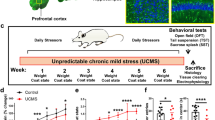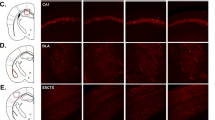Abstract
Chronic stress is well recognized to decrease the number of GFAP+ astrocytes within the prefrontal cortex (PFC). Recent research, however, has suggested that our understanding of how stress alters astrocytes may be incomplete. Specifically, chronic stress has been shown to induce a unique form of microglial remodelling, but it is not yet clear whether astrocytes also undergo similar structural modifications. Such alterations may be significant given the role of astrocytes in modulating synaptic function. Accordingly, in the current study we have examined changes in astrocyte morphology following exposure to chronic stress in adult rats, using three-dimensional digital reconstructions of astrocytes. Our analysis indicated that chronic stress produced profound atrophy of astrocyte process length, branching and volume. We additionally examined changes in astrocyte-specific S100β, which are both a putative astrocyte marker and a protein whose expression is associated with astrocyte distress. While we found that S100β levels were increased by stress, this increase was not correlated with atrophy. We further established that while chronic stress was associated with a decrease in astrocyte numbers when GFAP labelling was used as a marker, we could find no evidence of a decrease in the total number of cells, based on Nissl staining, or in the number of S100β+ cells. This finding suggests that chronic stress may not actually reduce astrocyte numbers and may instead selectively decrease GFAP expression. The results of the current study are significant as they indicate stress-induced astrocyte-mediated disturbances may not be due to a loss of cells but rather due to significant remodeling of the astrocyte network.










Similar content being viewed by others
References
Anderson CM, Swanson RA (2000) Astrocyte glutamate transport: review of properties, regulation, and physiological functions. Glia 32:1–14
Andreazza AC, Cassini C, Rosa AR et al (2007) Serum S100B and antioxidant enzymes in bipolar patients. J Psychiatr Res 41:523–529. doi:10.1016/j.jpsychires.2006.07.013
Arnsten AF (2009) Stress signalling pathways that impair prefrontal cortex structure and function. Nat Rev Neurosci 10:410–422. doi:10.1038/nrn2648
Banasr M, Duman RS (2007) Regulation of neurogenesis and gliogenesis by stress and antidepressant treatment. CNS Neurol Disord Drug Targets 6:311–320
Banasr M, Duman RS (2008) Keeping ‘trk’ of antidepressant actions. Neuron 59:349–351. doi:10.1016/j.neuron.2008.07.028
Banasr M, Dwyer JM, Duman RS (2011) Cell atrophy and loss in depression: reversal by antidepressant treatment. Curr Opin Cell Biol 23:730–737. doi:10.1016/j.ceb.2011.09.002
Beynon SB, Walker FR (2012) Microglial activation in the injured and healthy brain: what are we really talking about? Practical and theoretical issues associated with the measurement of changes in microglial morphology. Neuroscience 225:162–171. doi:10.1016/j.neuroscience.2012.07.029
Bianchi R, Giambanco I, Donato R (2010) S100B/RAGE-dependent activation of microglia via NF-kappaB and AP-1 Co-regulation of COX-2 expression by S100B, IL-1beta and TNF-alpha. Neurobiol Aging 31:665–677. doi:10.1016/j.neurobiolaging.2008.05.017
Broe M, Kril J, Halliday GM (2004) Astrocytic degeneration relates to the severity of disease in frontotemporal dementia. Brain 127:2214–2220. doi:10.1093/brain/awh250
Bushong EA, Martone ME, Jones YZ, Ellisman MH (2002) Protoplasmic astrocytes in CA1 stratum radiatum occupy separate anatomical domains. J Neurosci 22:183–192
Corvetti L, Capsoni S, Cattaneo A, Domenici L (2003) Postnatal development of GFAP in mouse visual cortex is not affected by light deprivation. Glia 41:404–414
Cotter DR, Pariante CM, Everall IP (2001) Glial cell abnormalities in major psychiatric disorders: the evidence and implications. Brain Res Bull 55:585–595
Czeh B, Simon M, Schmelting B, Hiemke C, Fuchs E (2006) Astroglial plasticity in the hippocampus is affected by chronic psychosocial stress and concomitant fluoxetine treatment. Neuropsychopharmacology 31:1616–1626. doi:10.1038/sj.npp.1300982
Ding DC, Gabbott PL, Totterdell S (2001) Differences in the laminar origin of projections from the medial prefrontal cortex to the nucleus accumbens shell and core regions in the rat. Brain Res 917:81–89
Drage MG, Holmes GL, Seyfried TN (2002) Hippocampal neurons and glia in epileptic EL mice. J Neurocytol 31:681–692
Drevets WC, Price JL, Simpson JR Jr et al (1997) Subgenual prefrontal cortex abnormalities in mood disorders. Nature 386:824–827. doi:10.1038/386824a0
Drevets WC, Price JL, Furey ML (2008) Brain structural and functional abnormalities in mood disorders: implications for neurocircuitry models of depression. Brain Struct Funct 213:93–118. doi:10.1007/s00429-008-0189-x
Eyre H, Baune BT (2012) Neuroplastic changes in depression: a role for the immune system. Psychoneuroendocrinology. doi:10.1016/j.psyneuen.2012.03.019
Gabbott PL, Warner TA, Jays PR, Salway P, Busby SJ (2005) Prefrontal cortex in the rat: projections to subcortical autonomic, motor, and limbic centers. J Comp Neurol 492:145–177. doi:10.1002/cne.20738
Garcia-Amado M, Prensa L (2012) Stereological analysis of neuron, glial and endothelial cell numbers in the human amygdaloid complex. PLoS One 7:e38692. doi:10.1371/journal.pone.0038692
Goldwater DS, Pavlides C, Hunter RG et al (2009) Structural and functional alterations to rat medial prefrontal cortex following chronic restraint stress and recovery. Neuroscience 164:798–808
Gosselin RD, Gibney S, O’Malley D, Dinan TG, Cryan JF (2009) Region specific decrease in glial fibrillary acidic protein immunoreactivity in the brain of a rat model of depression. Neuroscience 159:915–925. doi:10.1016/j.neuroscience.2008.10.018
Guidry C, King JL, Mason JO 3rd (2009) Fibrocontractive Muller cell phenotypes in proliferative diabetic retinopathy. Invest Ophthalmol Vis Sci 50:1929–1939. doi:10.1167/iovs.08-2475
Schafer DP, Lehrman EK, Stevens B (2013) The “quad-partite” synapse: microglia–synapse interactions in the developing and mature CNS. Glia 61(1):24–36. doi:10.1002/glia.22389 (Epub 2012 Jul 24)
Hammen C (2005) Stress and depression. Annu Rev Clin Psychol 1:293–319
Hinwood M, Morandini J, Day TA, Walker FR (2012) Evidence that microglia mediate the neurobiological effects of chronic psychological stress on the medial prefrontal cortex. Cereb Cortex 22:1442–1454. doi:10.1093/cercor/bhr229
Hinwood M, Tynan RJ, Charnley JL, Beynon SB, Day TA, Walker FR (2012) Chronic Stress Induced Remodeling of the Prefrontal Cortex: Structural Re-Organization of Microglia and the Inhibitory Effect of Minocycline. Cereb Cortex. doi:10.1093/cercor/bhs151
Hu J, Van Eldik LJ (1996) S100 beta induces apoptotic cell death in cultured astrocytes via a nitric oxide-dependent pathway. Biochim Biophys Acta 1313:239–245
Huttunen HJ, Kuja-Panula J, Sorci G, Agneletti AL, Donato R, Rauvala H (2000) Coregulation of neurite outgrowth and cell survival by amphoterin and S100 proteins through receptor for advanced glycation end products (RAGE) activation. J Biol Chem 275:40096–40105. doi:10.1074/jbc.M006993200
Imbe H, Kimura A, Donishi T, Kaneoke Y (2012) Chronic restraint stress decreases glial fibrillary acidic protein and glutamate transporter in the periaqueductal gray matter. Neuroscience 223:209–218. doi:10.1016/j.neuroscience.2012.08.007
Izquierdo A, Wellman CL, Holmes A (2006) Brief uncontrollable stress causes dendritic retraction in infralimbic cortex and resistance to fear extinction in mice. J Neurosci 26:5733–5738. doi:10.1523/JNEUROSCI.0474-06.2006
Jinno S, Fleischer F, Eckel S, Schmidt V, Kosaka T (2007) Spatial arrangement of microglia in the mouse hippocampus: a stereological study in comparison with astrocytes. Glia 55:1334–1347
Kreutzberg GW (1996) Microglia: a sensor for pathological events in the CNS. Trends Neurosci 19:312–318. doi:0166223696100497
Michetti F, Corvino V, Geloso MC et al (2012) The S100B protein in biological fluids: more than a lifelong biomarker of brain distress. J Neurochem 120:644–659. doi:10.1111/j.1471-4159.2011.07612.x
Montgomery DL (1994) Astrocytes: form, functions, and roles in disease. Vet Pathol 31:145–167
Morshedi MM, Meredith GE (2007) Differential laminar effects of amphetamine on prefrontal parvalbumin interneurons. Neuroscience 149:617–624. doi:10.1016/j.neuroscience.2007.07.047
Ongur D, Drevets WC, Price JL (1998) Glial reduction in the subgenual prefrontal cortex in mood disorders. Proc Natl Acad Sci USA 95:13290–13295
Paxinos G, Watson C (1998) The rat brain in stereotaxic coordinates. Academic Press, Waltham
Petzold A, Eikelenboom MJ, Gveric D et al (2002) Markers for different glial cell responses in multiple sclerosis: clinical and pathological correlations. Brain 125:1462–1473
Pilati N, Barker M, Panteleimonitis S, Donga R, Hamann M (2008) A rapid method combining Golgi and Nissl staining to study neuronal morphology and cytoarchitecture. J Histochem Cytochem 56:539–550. doi:10.1369/jhc.2008.950246
Radley JJ, Sisti HM, Hao J et al (2004) Chronic behavioral stress induces apical dendritic reorganization in pyramidal neurons of the medial prefrontal cortex. Neuroscience 125:1–6
Radley JJ, Arias CM, Sawchenko PE (2006) Regional differentiation of the medial prefrontal cortex in regulating adaptive responses to acute emotional stress. J Neurosci 26:12967–12976. doi:10.1523/JNEUROSCI.4297-06.2006
Radley JJ, Rocher AB, Miller M et al (2006) Repeated stress induces dendritic spine loss in the rat medial prefrontal cortex. Cereb Cortex 16:313–320. doi:10.1093/cercor/bhi104
Radley JJ, Rocher AB, Rodriguez A et al (2008) Repeated stress alters dendritic spine morphology in the rat medial prefrontal cortex. J Comp Neurol 507:1141–1150. doi:10.1002/cne.21588
Rajkowska G (2000) Histopathology of the prefrontal cortex in major depression: what does it tell us about dysfunctional monoaminergic circuits? Prog Brain Res 126:397–412. doi:10.1016/S0079-6123(00)26026-3
Rajkowska G (2002) Cell pathology in mood disorders. Semin Clin Neuropsychiatry 7:281–292
Rajkowska G, Miguel-Hidalgo JJ (2007) Gliogenesis and glial pathology in depression. CNS Neurol Disord Drug Targets 6:219–233
Ramkumar K, Srikumar BN, Venkatasubramanian D, Siva R, Shankaranarayana Rao BS, Raju TR (2012) Reversal of stress-induced dendritic atrophy in the prefrontal cortex by intracranial self-stimulation. J Neural Transm 119:533–543. doi:10.1007/s00702-011-0740-4
Saur L, Baptista PP, de Senna PN et al (2013) Physical exercise increases GFAP expression and induces morphological changes in hippocampal astrocytes. Brain Struct Funct. doi:10.1007/s00429-012-0500-8
Savchenko VL, McKanna JA, Nikonenko IR, Skibo GG (2000) Microglia and astrocytes in the adult rat brain: comparative immunocytochemical analysis demonstrates the efficacy of lipocortin 1 immunoreactivity. Neuroscience 96:195–203
Schroeter ML, Abdul-Khaliq H, Krebs M, Diefenbacher A, Blasig IE (2008) Serum markers support disease-specific glial pathology in major depression. J Affect Disord 111:271–280. doi:10.1016/j.jad.2008.03.005
Schroeter ML, Steiner J, Mueller K (2011) Glial pathology is modified by age in mood disorders—a systematic meta-analysis of serum S100B in vivo studies. J Affect Disord 134:32–38. doi:10.1016/j.jad.2010.11.008
Shansky RM, Hamo C, Hof PR, McEwen BS, Morrison JH (2009) Stress-induced dendritic remodeling in the prefrontal cortex is circuit specific. Cereb Cortex 19:2479–2484. doi:bhp00310.1093/cercor/bhp003
Sofroniew MV, Vinters HV (2010) Astrocytes: biology and pathology. Acta Neuropathol 119:7–35. doi:10.1007/s00401-009-0619-8
Sotelo J, Toh BH, Lolait SJ, Yildiz A, Osung O, Holborow EJ (1980) Cytoplasmic intermediate filaments in cultured glial cells. Neuropathol Appl Neurobiol 6:291–298
Tremblay ME, Majewska AK (2011) A role for microglia in synaptic plasticity? Commun Integr Biol 4:220–222. doi:10.4161/cib.4.2.14506
Tynan RJ, Naicker S, Hinwood M et al (2010) Chronic stress alters the density and morphology of microglia in a subset of stress-responsive brain regions. Brain Behav Immun 24:1058–1068. doi:10.1016/j.bbi.2010.02.001
Van Eldik LJ, Griffin WS (1994) S100 beta expression in Alzheimer’s disease: relation to neuropathology in brain regions. Biochim Biophys Acta 1223:398–403
Wearne SL, Rodriguez A, Ehlenberger DB, Rocher AB, Henderson SC, Hof PR (2005) New techniques for imaging, digitization and analysis of three-dimensional neural morphology on multiple scales. Neuroscience 136:661–680. doi:10.1016/j.neuroscience.2005.05.053
Yang CY, Matsuzaki T, Iijima N, Kajimura N, Ozawa H (2012) Morphofunctional changes of the astrocyte in rat hippocampus under different corticosteroid conditions. Medical molecular morphology 45:206–213. doi:10.1007/s00795-011-0561-4
Ye Y, Wang G, Wang H, Wang X (2011) Brain-derived neurotrophic factor (BDNF) infusion restored astrocytic plasticity in the hippocampus of a rat model of depression. Neurosci Lett 503:15–19. doi:10.1016/j.neulet.2011.07.055
You Y, Gupta VK, Graham SL, Klistorner A (2012) Anterograde degeneration along the visual pathway after optic nerve injury. PLoS One 7:e52061. doi:10.1371/journal.pone.0052061
Acknowledgments
These studies were supported by funding from the Australian National Health and Medical Research Council, the Hunter Medical Research Institute, and the University of Newcastle’s Centre for Translational Neuroscience and Mental Health Research.
Author information
Authors and Affiliations
Corresponding author
Rights and permissions
About this article
Cite this article
Tynan, R.J., Beynon, S.B., Hinwood, M. et al. Chronic stress-induced disruption of the astrocyte network is driven by structural atrophy and not loss of astrocytes. Acta Neuropathol 126, 75–91 (2013). https://doi.org/10.1007/s00401-013-1102-0
Received:
Revised:
Accepted:
Published:
Issue Date:
DOI: https://doi.org/10.1007/s00401-013-1102-0




